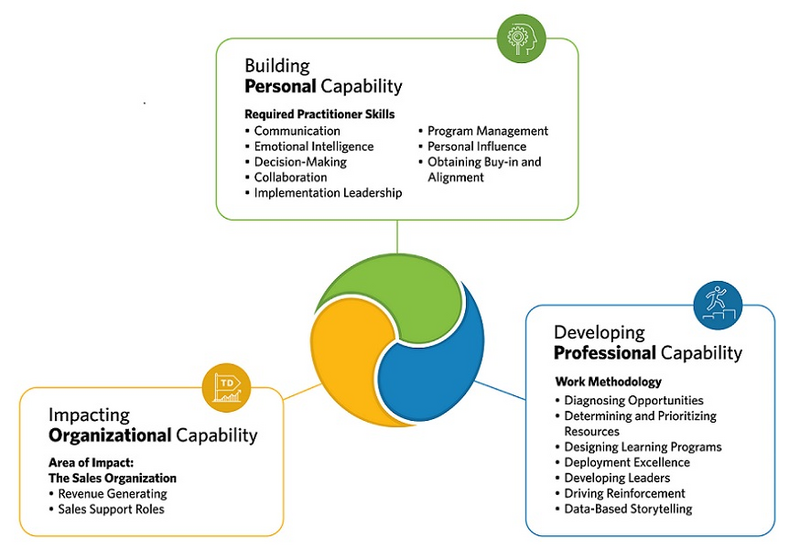ATD Blog
Introducing ATD’s Developing Sales Capability Model
Tue May 23 2023

In the early days of sales enablement, you might have found one or two people who were tasked with several sales operations or support tasks required to keep the organization going. During that time period, if you were to ask five different people to define sales enablement, you’d likely get five different answers.
Today, sales enablement has evolved into a robust, meaningful profession full of practitioners aligning sales strategy with tactics and partnering with leadership to drive results within the sales organization. However, one reality remains from those early days—the range of activities that can fall to sales enablement is still very broad
One of the bigger examples is the responsibility for leading the development of sales capability. Doing this well means borrowing best practices from learning and development (L&D) practitioners and calibrating these methods for deployment to revenue-generating teams.
In serving the sales enablement community of practice, ATD has created a new model for sales enablement practitioners. The end-to-end model incorporates what works from traditional L&D, while contextualizing it for the sales function. The model has three components, focusing on the Personal, Professional, and Organizational realities of developing capability.

In this blog, let’s focus on the seven activities required to develop Professional capability. They are:
1. Diagnosing Opportunities
2. Determining and Prioritizing Resources
3. Designing Learning Programs
4. Deployment Excellence
5. Developing Leaders
6. Driving Reinforcement
7. Data-Based Storytelling
Steps 1 & 2: Getting Started
The first two steps in this part of the model describe what it takes to get started with the Developing Sales Capability—think of these as your planning, scoping, and early alignment phases.
Diagnosing Opportunities: Collaborate with sales leaders and business partners to conduct a thorough needs analysis of the organization’s go-to-market strategy, sales development needs, and skill gaps. Explore and recommend early solution options.
Determining and Prioritizing Resources: Articulate the level of effort to develop and implement proposed solutions, including time, money, SMEs, enablement technology, etc. Prioritize the most impactful development options based on desired outcomes or anticipated results.
Steps 3 & 4: Program Development
The next two steps are repeated for each greenlit development priority in your organization. They cover the practices behind great program design and management.
Designing Learning Programs: Gain directional buy-in with sales leaders and stakeholders on program and course objectives. Leverage best practice instructional design principles and industry thought leadership to build and obtain sales methodologies, teaching content, and activities. Select delivery methods (modality, just-in-time training, manager coaching, etc.) that are best suited to each learning topic and tailored to a sales audience’s needs.
Deployment Excellence: Build implementation roadmaps to successfully launch sales development initiatives within the organization. Core elements of these plans include communication strategy, executive sponsors and other key roles and responsibilities, timing and milestones, expected outcomes, feedback loops, and pre- and post-launch touchpoints.
Steps 5 & 6: Making Development Sticky
These next two steps focus on getting traction through advocacy and learning reinforcement—which are often overlooked yet required to drive behavior change in salespeople.
Developing Leaders: Equip sales managers and leaders to drive revenue and champion development initiatives by providing the required skills, tools, and processes to coach, train, and lead a high-performing sales organization.
Driving Reinforcement: Develop a learning reinforcement strategy to pull through key ideas and concepts into the workstream. Plans should identify key leading/lagging performance indicators, as well as the catalysts, tips, tricks, and people/leaders playing a critical role in sustaining the learning until desired performance outcomes are reached.
Step 7: Reporting Results
Finally, the first step of the model and this last step are linked—through great planning and tracking, we can know how our sales development investment paid off and communicate it accordingly.
Data-Based Storytelling: Communicate and demonstrate the efficacy of development initiatives concisely and engagingly. Utilize the best data sources to create compelling visuals and a story-based approach that communicates outcomes in a business-relevant way.
This Developing Sales Capability model has the potential to educate leadership in our companies about how we approach our work. It will also provide standards and language to ensure the methodology we use to develop sales teams is always built on the bedrock of best industry practices yet fully calibrated for revenue-generating organizations.
